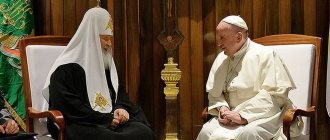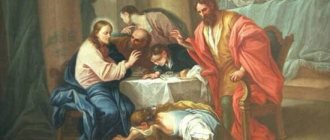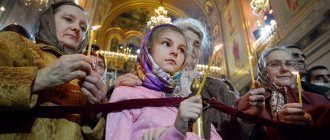Church Apocalypse: why the Bolsheviks demolished churches
From the editors of RP: The author of the article published below is not a Marxist, but a convinced supporter of Soviet socialism, who tried to find out whether the myth that is currently being actively spread by Russian bourgeois propaganda has at least some basis. In this connection, the article contains some flaws - incorrect formulations from the point of view of Marxism-Leninism. But the main thing is that the facts presented in this material are absolutely correct, as are the author’s conclusions, and this is its value.
Falsifications “about the murder of priests” and a purely church Apocalypse
Now too many lies and slander are being thrown down on the Russian people, on their culture, on the history of the country from the outside, which, according to the principles it proclaims, it would seem, on the contrary, should have protected it - from the Russian Orthodox Church and its neophytes. In fact, now the Russian Orthodox Church, with this slander, is increasingly and increasingly putting itself in a position that is openly not only anti-Soviet, but also completely ANTI-RUSSIAN. Anti-Russian because our people have already made their choice once - and this choice was Soviet Power and Russian socialism. Both are his, the people’s, brainchild. And if the Russian Orthodox Church is trying to bring back those times when our people were in slavery, then can we put up with this? Moreover, these attempts to twist our brains and break our hands are accompanied by shameless lies.
Now we will talk about one of the most popular slanderous myths: “About the murder of priests by order of the Bolsheviks and the villainous destruction of churches belonging to the Russian Orthodox Church.”
I warn you right away that the material is partially not mine, some things were found out and installed by others, and links to their materials are provided. In addition, anyone who is not a fool can check all the facts presented here. Fast or slow is the tenth thing. The main thing is Truth. And if some Orthodox suddenly begins to assert the opposite, then it is worth asking such a blockhead: “Did Christ teach you to LIE? Or did he still call you to follow the truth?”
So, the myth is the first of two related ones - “Lenin’s Decree”.
A certain A. Latyshev, author of the book “Declassified Lenin” [1] and articles like this one: “On the declassification of Lenin’s works. To the 132nd anniversary of his birth,” talks about his work in the archives as follows:
“...after the August 1991 events. I was given a special pass to familiarize myself with secret documents about Lenin. The authorities thought to find the reason for the coup in the past. I sat in the archives from morning to evening, and my hair stood on end. After all, I always believed in Lenin, but after the first thirty documents I read, I was simply shocked.”
What documents shook Mr. Latyshev’s faith so much? For example, this one:
“... Let us present the completely terrible document, which was repeatedly published in facsimile version:
“May 1, 1919 N 13666/2.
Chairman of the Cheka Comrade. Dzerzhinsky F.E.
NOTE
In accordance with the decision of the All-Russian Central Executive Committee and the Council. Nar. The commissars need to put an end to priests and religion as quickly as possible. Popovs should be arrested as counter-revolutionaries and saboteurs, and shot mercilessly and everywhere. And as much as possible. Churches are subject to closure. The premises of the temples should be sealed and turned into warehouses. Chairman of the All-Russian Central Executive Committee Kalinin, Chairman of the Council. Nar. Commissars Ulyanov (Lenin)".
The outgoing number contains the number of the devil!
Like this: mercilessly shoot all Orthodox priests, turn all Orthodox churches into warehouses.
(Typical is the publication in the communist Pravda of the resolution of the Politburo of the Central Committee of the All-Union Communist Party of Bolsheviks dated November 11, 1939, signed by I. Stalin: “Instruction of Comrade Lenin dated May 1, 1919 for No. 13666/2 “On the fight against priests and religion,” addressed to the Chairman of the Cheka F.E. Dzerzhinsky, and all relevant instructions of the OPTU-NKVD regarding the persecution of Church ministers and Orthodox believers - CANCEL.")"
You can't say anything - it's a terrible document. It makes your hair stand on end and smells of sulfur...
However, having coped with the first attack of fear, we notice that:
1. The All-Russian Central Executive Committee and the Council of People's Commissars did not issue a single document with the title “Instruction” during the entire period of their activity, only resolutions and decrees signed by the heads of these bodies. Anyone can verify this personally by looking at the collections “Decrees of the Soviet Power”. Moreover, in the practice of party and state office work, there have never been documents with the title “Instruction”.
2. No serial numbers were assigned to such documents. However, serial number 13666/2 implies the presence of many thousands of such “instructions” in government records. WHERE ARE THEY?
3. “Lenin’s instruction of May 1, 1919” is absent from RGASPI, although all documents today (except for his medical history) have been declassified.
4. Among Lenin’s papers dating back to May 1, 1919, there are no anti-religious ones - these are several resolutions of the Small Council of People’s Commissars signed by him, and they all relate to minor economic issues.
5. Missing “Lenin’s Directive of May 1, 1919” and in the State Archive of the Russian Federation, where the funds of the Council of People's Commissars and the All-Russian Central Executive Committee are stored.
6. The Central Archive of the FSB of Russia and the Archive of the President of the Russian Federation gave a negative review of the presence of this “document” in their official letters.
7. There was no secret “decision of the All-Russian Central Executive Committee and the Council of People's Commissars of 1917-1919. about the need to “put an end to priests and religion as quickly as possible,” in pursuance of which “Lenin’s Directive of May 1, 1919” as if it had been released.
By the way, Latyshev forgot a “small” detail - he did not indicate the number, date, or name of this “decision”.
8. There are no “instructions of the Cheka-OGPU-NKVD” with references to this “instruction”, there are no documents about its implementation.
9. There was no publication in Pravda.
10. On November 11, 1939, there really were decisions of the Politburo. However, they did not concern church issues.
As you can see, it’s a pure fake.
Who needed it?
Judge for yourself:
Extract from the budget of Yeltsin’s election headquarters, 1996 (See Kompromat.ru): “...The book “Declassified Lenin.” 95 million rub. Approved. Paid."
Chekalin Yuri
Myth two: “Anathema to the Bolsheviks and the “villainous” destruction of property belonging to the Russian Orthodox Church”
As usual, in order to lie, professional scammers use the technique: “Hide that part of the information that would change the meaning to the opposite.” Therefore, when they say “the Bolsheviks destroyed Orthodox churches,” they are hiding extremely important information from the recipient. The recipient gets the impression, which is extremely far from reality, that “the Bolsheviks TOOK away its property from the Russian Orthodox Church and destroyed it. And even the priests were shot. Everyone. And if the believers were not shot, then they were dispersed.” The result is an extremely vile multi-level lie, which the recipient, who has no other truthful information, often blindly believes. Perceives uncritically.
Therefore, let's figure out who exactly owned those temples and their property. Let's see what happened in reality, and let's not indiscriminately believe everything that unscrupulous propagandists palm off on us.
According to their myth, it is assumed that the churches did not belong to the state, but to the Russian Orthodox Church. That the church was robbed and so on.
Well, well, this is what any specialist historian will tell you on this matter, if he is, of course, a historian and not a banal liberal propagandist.
The anathema against the Bolsheviks was caused by the purely material interests of clergy.
The fact is that in Russia before the revolution there were no special church properties, but only state property of the ecclesiastical department. The Bolsheviks LEGALLY, including under pre-revolutionary legislation, had every right to take away everything and everyone from the church (understood as a government institution), since nothing belonged to it.
Before the revolution, there was no special separate concept of church property. All church property was part of state property. It was called that - the property of the Department of Orthodox Faith, i.e. property of the Holy Synod. Analogs - property of the military department, property of the naval department, property of the Ministry of Railways, etc. All these ministries and departments only managed, disposed of and used state property.
The Church as a whole (understood as an association of believers), metropolises, dioceses, monasteries and even parishes were neither owners nor legal entities - the Holy Synod was the legal entity. All the property that the church used was only state property. Even all donations that believers gave legally immediately became state property.
Of course, in the “Code of Punishments” there was a special article about “sacrileges” - i.e. about those who stole church property, and a separate special punishment was determined for such. But there were also special articles, for example, about the theft and damage to railway property and about logging in state-owned forests, etc. You can specifically look through the entire multi-volume set of laws of the Russian Empire and you will not find anywhere a mention of the fact that there are special non-state church property official church. Everywhere church property is considered only as part of state property. The property of other faiths was indeed not part of state property.
In addition, the entire Russian Orthodox Church was officially state funding , which the Bolsheviks abolished, separating the church from the state and thereby giving it true freedom, so to speak, realizing in practice the right to freedom of conscience. In the Russian Empire there was a special item of budget expenditures - “expenses of the Holy Synod”. Officially, all clergy (except monks) and secular officials of the Synod received state salaries.
In the Russian historical archives there is, for example, a monastic order of Peter I, to whom all monastic property was transferred for management precisely as state property. Therefore, in particular, the seizure of bells and precious metals from churches and monasteries under Peter was not confiscation or expropriation, but simply the use by the state of its own property for other purposes and for a different purpose.
There are also documents on the creation of the Holy Synod and the transfer to it for use, disposal and management of all church property precisely as state property.
Under Catherine II, the transfer of those lands and those peasants that were transferred to the monasteries for use was carried out, from the monasteries directly to the state administration and disposal. This is incorrectly called "secularization", but in reality it was simply a transfer of property from one department to another.
So, when the current Nikonian priests scream that the church was robbed by godless Bolsheviks, they are deliberately and selfishly misleading everyone . The church, understood as a meeting of believers (and not as a state institution), before the revolution did not and could not have any property and it was physically impossible to rob it.
These are the facts of history.
Consequence of betrayal: A purely church apocalypse.
In previous parts, we examined facts that expose wild lies and slander, but which today are presented as the ultimate truth.
Briefly they are:
1) No Lenin’s decree stating that it is necessary to shoot all priests and destroy churches does not exist in nature. And it never existed. This is a fake - a remake of the Yeltsin period of Russian history.
2) All the property that the Bolsheviks allegedly took away from the Russian Orthodox Church never actually belonged to the Russian Orthodox Church, but was the property of the state - first of the Russian Empire, and then of Soviet Russia. The Soviet government received all this property - churches, lands and everything that stands on them - as an inheritance from the tsarist government. And if all these temples belong to the state, then the state has everything it deems necessary to do with the temples.
Now the Russian Orthodox Church is trying to say that they “destroyed churches” and at the same time it was assumed that before the destruction, the priests were almost kicked out and the crowds of believers were dispersed.
But this is not true either.
There were no “crowds of believers” who would be “thrown out of churches.” Often there were no priests themselves. And not because someone there was “shot by Jewish Bolsheviks in leather jackets.”
The fact is that here, too, the liars from the Russian Orthodox Church and the Russian bourgeois state “gently keep silent” about very inconvenient facts of history, which at first glance are not related to each other, but, nevertheless, are most directly related to the matter.
Fact one: the Russian Orthodox Church as a branch of the Okhrana
Yes, the priests of the Russian Orthodox Church were obliged to report... to the Tsarist Okhrana (an institution in the Republic of Ingushetia similar to the modern FSB, engaged in political investigation, more details here). Moreover, it was their duty to report on all the “troublemakers” or seditious thoughts that exist among the people. That is, in fact, there was no such thing as the “secret of confession” in the Russian Orthodox Church of the Russian Empire! And the priests were the most primitive agents of the universally despised Okhrana.
The fact that they handed over batches of Orthodox Christians is a fact that has long been known and recorded in the documents of the Okhrana itself. The fact that priests hand over people to the Okhrana after confession was also well known in the Russian one. How they knew very well what happens to those who, out of their naivety and stupid belief in the “holiness and infallibility of the holy fathers,” suddenly decided to share with them their innermost, but in some ways seditious, thoughts.
Were you punished for “seditious thoughts”?
Yes exactly. The Russian Empire is by no means a “crunch of French bread”, as Russian propagandists on the oligarchs’ pay serve it today. It was no coincidence that the tsarist autocracy was considered the most reactionary and despotic in the world of that time.
According to the criminal legislation of that time, not only the act was punished, but also INTENT! Moreover, other intent was often punished many times more severely than a criminal act .
That is, a citizen came to confession and repented before the Holy Father of unrighteous thoughts (and believe me, there were reasons - Russia has not escaped from constant hunger strikes for half a thousand years! When hungry children sit on shelves, anything can come to mind - for example, about the injustice of the existing life structure, when some are mad about fat, while others don’t even have a crumb of bread, although they work from dawn to dusk.). And the next day, based on the denunciation of that same “holy father,” the citizen is taken for mikitki and sentenced to hard labor or imprisoned only for these same “unrighteous thoughts.”
Quite a typical phenomenon for those times. Don't believe me? Check it out! Criminal law, and not only those of those times, was published long ago. Don't be lazy, read. For example, here. If you don’t believe online resources, go to large libraries and read there. Published then, back in tsarist times, so as not to later lament about “Bolshevik propaganda,” becoming like liars feeding from the hands of modern masters.
What do you think such actions of the “holy fathers” could have caused in the ranks of believers? Hardly warm feelings, right? For everyone saw that the priests “have no truth.”
Also, the outright betrayal of the interests of the people did not contribute to raising the authority of the Russian Orthodox Church among the people. When the priests imposed the “necessary” candidates in the elections (a familiar situation in our times, isn’t it?), they did their best to cover up and justify with their words all the most vile and unjust acts of the tsarist regime. Mass floggings, beatings and executions of peasants for protests caused by complete despair, outright and undisguised robbery, when everything was taken away from them for debts to the treasury or landowners, without even leaving the bare minimum for the survival of the family. The Church justified any meanness on the part of the tsarist authorities, any cruelty, any oppression and oppression of the landowners.
The Russian Orthodox Church was generally the most consistent and zealous supporter of tsarist despotism. Each time, supporting autocracy and the power of the masters, the priests thereby opposed the will and interests of the people, which means they increasingly lost their authority among the masses.
Extortions from local priests did not add to the authority of the Russian Orthodox Church. Their greed found its expression even in thousands of sayings and proverbs that the Russian people composed about priests. Quite often in the documents of those times there are simply egregious cases. And the smallest of them, but very significant, is when the priest refused to perform the funeral service for the deceased on the grounds that the poor relatives did not have enough kopecks to pay him “for his diligence.” (Analogues of this behavior of the priests of the Russian Orthodox Church are manifested even today, for example, the same thing was observed after the terrible flood in the city of Krymsk in July 2012). In general, any priest’s sneeze in the Republic of Ingushetia was furnished with such lists and prices that one should not be surprised at the caricatures of priests during the first years of Soviet power, when all this was still too fresh in the memory of the Russian people - everything is true.
What did this lead to?
It’s not difficult to guess - of course, to general contempt for the Russian Orthodox Church and often to undisguised hatred that has accumulated over centuries. Hatred not so much for religion itself, but for priests. Many people in Russia at that time, while remaining believers, were ready to hang this or that priest with their own hands. (I think the situation is about the same now.)
So the Russian Orthodox Church and faith in those days “parted like ships at sea.” And then all this was cast in the total spontaneous “atheism” of the Russian people. This, too, is now carefully hushed up, and sometimes brazenly distorted to the exact opposite. This is
Fact two. Massive hostility towards the Russian Orthodox Church.
This resulted in a phenomenon that amazed all contemporaries: when the Provisional Government, which came to power in the country in February 1917, abolished compulsory church attendance, attendance at churches, services, etc. immediately fell tenfold ! The Russian people, as they now say, “voted with their feet” against the Russian Orthodox Church and its functionaries.
And then the fall of the absolute power of the Russian Orthodox Church was only a matter of time.
Churches, having lost their parishioners, quite naturally fell into disrepair. Moreover, first of all, small churches began to deteriorate, like the “Gundyaevkas” now being built everywhere (which, we believe, will face approximately the same fate). The priests who were found there were simply out of work. And when, by the decree of the Council of People's Commissars of the RSFSR of January 23 (February 5), 1918, the church was separated from the state, a real Apocalypse broke out for the priests.
The priests of the Russian Orthodox Church simply had nothing to live with. After all, they were all fed from the hands of the state - they were supported by it. Everything that the priests collected from the believers was only a pleasant, but insignificant addition to the goodies that the state initially provided to the Russian Orthodox Church. It is not for nothing that in the epic of the Russian people, the priest is traditionally portrayed as fat, greedy and lazy. And this Apocalypse and “Last Judgment” for the church was the natural result of many centuries of betrayal of the people. The people condemned and punished the priests and the church.
The voice of the people is the voice of God, isn't it? The priests themselves say so. However, the Russian Orthodox Church has now firmly “forgotten” this Truth.
Have people stopped believing in God?
Yes, as a matter of fact, he was not much of a believer to begin with. This is evidenced by the reports of the priests themselves. See, for example, a collection of such reports entitled “The Truth about the Orthodox People.”
What is the essence of this “Church Apocalypse”?
Yes, the fact is that if the priests were deprived of feeding from the state, then, naturally, they could feed themselves only from the offerings of citizens - from what the religious community could collect.
BUT could religious communities afford to maintain all the churches and small churches in the conditions of massive and systematic famine in Russia? And were those communities really numerous and populous?
As I mentioned above, there were countless different “proto-Gundyaevkas” - small churches scattered throughout the cities of Russia. They often looked like just rough-hewn sheds with a cross on the roof. As a matter of fact, there were no such “sheds” in 90% of all Russian churches. It was these “churches” that people stopped going to in the first place.
What should the priests who previously served in them do? Die of hunger? Or give up everything and go to work?
Naturally, those who were not complete idiots chose the latter. And the “churches” abandoned by the people fell into complete desolation and quite quickly turned into either latrines, or shelters for vagabonds, or both. In a word, a breeding ground for infection.
sane do first with such sheds?
Yes, tear them down to hell, since no one needs them anymore! Which, in fact, is what the Soviet government did. Those. It was not just some of the most valuable temples and unique buildings that were demolished, but 90% of them were sheds that had fallen into complete disrepair as premises, completely unclaimed and of no interest to anyone. Including the state.
But now there is a great shout, the sound of shirts being torn at the chest and hands being wringed: “The damned Bolsheviks destroyed churches en masse!!!!!!!!!!!!.” (By the way! I’ve seen exactly this “formatization” of this nonsense many times - with a forest of exclamation marks).
Further about “works of architecture” and other “churches”.
Yes, indeed, many churches were destroyed along the way, which did not even come close to the category of “outhouse barn.” There were indeed works of art and ancient architecture in Russia. But! (Again, that damned “But”!)
Firstly, these were abandoned buildings.
Secondly, who originally owned these buildings?
They belonged to the state!
Did the state have the right to do with its property as it pleased?
Of course it did! Full legal and moral right.
Why also moral?
But because no one maintained these establishments, abandoned and abandoned
Does the latter matter?
Yes, it has. The priests were unable to support them. And for this reason alone - abandonment and uselessness to the Russian people - the Soviet state had every right to refurbish the building that belonged to it (!), turning it into something really needed by the people - a hospital, a school, a cultural center, a library, a Children's Art Center, etc. .d. Yes, even to the stables! Anything more useful than just a dirty public toilet! Or demolish this building and build in its place a new one, which is extremely necessary for the people - the same hospitals, schools, Houses of Culture, kindergartens, etc.
It is necessary to mention here that it was Lenin who put a barrier to the mass demolition of churches. There was a special government decree on historical monuments, which included many churches, which people, in a fit of enthusiasm, rushed to demolish, without really thinking about their cultural and historical value. It was this decree, in particular, that St. Basil's Cathedral and many other religious buildings were preserved and saved from destruction. But the ideologists of modern gentlemen prefer not to remember this fact - it is vital for them to present the Bolsheviks as enemies of the people, and not as their defenders.
It is no coincidence that I said above - “the people are in a fit of enthusiasm.” Yes, that's what happened. And here there are no machinations of some kind of “zhYdo-Bolsheviks in leather jackets.” And there is no total “zhYdo-Bolshevik conspiracy against the Russian Orthodox Church” either. This is all too clearly seen in the composition of the Soviets and the government of Soviet Russia. In reality, Jews then constituted an absolute minority. So the wild Black Hundred nonsense spread in the Russian media is better left on the conscience of those who are involved in it and those who naively believe in it. These citizens can be recommended to double-check this fact by finding out exactly the number of Jews in the government of Soviet Russia - after all, now everything has been published and everything is online.
There really was popular enthusiasm for the demolition of churches. And a considerable one. Do not forget the huge charge of hatred towards priests that has accumulated among the people over many years. The Church was perceived as part of the hated tsarism, and quite rightly perceived - it was an integral part of it, receiving money from it “for faithful service”! Therefore, the peasants, having suffered plenty from the tsar, landowners and priests, people often hurried to get rid of the “legacy of the damned past” as quickly as possible. This saying, by the way, had a very serious meaning back then. For this “heritage” also KILLED. Moreover, it killed in the most literal sense of the word.
Who initiated the Civil War?
Certainly not the Bolsheviks and not the Soviet Power, no matter how our new-found masters try to prove the opposite to us. They did everything to prevent war, immensely wanting the initially bloodless socialist revolution to smoothly develop into the normal peaceful construction of a new society. Are you surprised by the word “bloodless”? Did they tell you otherwise? Alas, they lied again! For fun, compare, for example, the number of deaths in the Russian socialist revolution - about 500 people for the entire huge country - with the French bourgeois revolution. So, the last one, called the Great French Revolution, took away almost a third of the country's population.
It was not the Bolsheviks who started the civil war in Russia.
Firstly , it was the Entente. These countries, or rather the financial tycoons who ruled them, lost all their property in Russia. According to the act of nationalization. Naturally, they longed to return everything back. For yourself. With interest. Therefore, they looked for any opportunity to overthrow the power of the Soviets.
And since they very quickly became convinced that the power of the working people is exceptionally strong and that it is supported by the absolute majority of the Russian people, they naturally bet on those who also lost and also want to return what they had. To fight with their hands against the hated “power of the rebel mob.” We provided them with everything we could. Against the poor Soviets.
Secondly , these were the same ones on whom the Entente relied, who also lost property in Russia and who wanted to return the land, and factories, and even the dear to their hearts and such pleasant serfdom, when you don’t have to do anything yourself , and the peasants who work from morning until late at night do everything for you. It is clear that the working people of Russia strongly disagreed with this.
Who were they, these “offended and dispossessed”?
Yes, noble landowners, factory owners and... priests!
After all, in reality, the clergy were literally DENIED OF A PIECE OF BREAD! The state of the working people refused to support them, and the people also had no desire to do this, because they themselves were terribly hungry, driven to extreme poverty and despair by the imperialist war and, in general, by the delights of tsarist rule.
What were the sentiments of the majority of priests in relation to Soviet power and the working people, who “turned their back on them”?
Only wild, bestial anger. The exceptions were those priests who nevertheless retained their parishes and, at least somehow, were supported along with the churches by their parishioners. But there were very few of them. The people were really happy beyond belief that this responsibility of “feeding these parasites” had been taken off their hands.
If among the priests there was wild anger towards the Soviet regime (and, I repeat, the majority of them lost income), then what did they soon become in relation to the Soviet regime?
Right! The worst enemies who called on the people to violently overthrow this government, participated in real armed uprisings against this government, and helped the counter-revolution in every possible way - foreign interventionists and White Guards.
What was the fate of those who were caught doing this?
It is quite natural that they were destroyed. They hanged and shot. For specific acts against the working people - murder, torture, torture, etc., regardless of their previous titles and merits.
And, note, no “special instructions” were needed for these shootings and executions. The priests themselves have outlawed themselves. And here it was enough to simply apply the law - the same one that exists in every state, since any ruling class always defends its political power.
And since there were too many priests in the ranks of the enemies of Soviet power, how did the people soon begin to perceive them, if for them they were those who again wanted to drive him into slavery?
Seeing such an attitude towards himself, he simply wrote them all down as enemies, and that was the end of it! With all the ensuing consequences. And I was not mistaken, by the way, as we now see clearly after 70 years. The Russian Orthodox Church does not stand strongly for the USSR, nor does it stand for the country to which the overwhelming majority of the Russian population is now striving to return. She took the side of the oligarchs and pleases them in everything, carefully protecting their power, their dominance and their right to oppress and rob the Russian people.
And then, in the civil war, what did the Russian Orthodox Church rush to do?
Declare anathema to Soviet Power. And to our own working people, whose Soviet power it was. Because he “turned his back on the Holy Church” and no longer wants to bend his back to the parasites.
Actually, the main reason for the anathema and hatred of the priests towards Soviet power, as mentioned above, was an economic, material and selfish reason - the deprivation of their feeding from the state.
And then put yourself in the place of your ancestors. You have won political power. Finally, this government began to do exactly what the working people had long wanted (and this was really so - otherwise no one would have supported the Soviets in the civil war!), and then some bastard, who had previously appeared in speeches against the people, announces anathema to this PEOPLE's power!
What will be the attitude towards this structure? Moreover, against the backdrop of famine and outright devastation and economic disaster into which the tsarist government plunged the country. Yes, only one thing: “Kill the bastards!!!”
But this is not the whole point of the current situation!
Despite previous “merits,” a fair, albeit relatively small, proportion of the country’s citizens still cherished some illusions in relation to the Russian Orthodox Church. And she was, in addition, a believer. What is this declaration of anathema for them? This is a call to fight “For the Glory of Christ,” etc. and so on. Those. This anathema split society and set one part of it against another.
What is this if not the direct initiation of a civil war? To the great joy of the Entente countries, various Rockefellers, Rothschilds, Morgans and other world parasites.
All this was OBVIOUS to our ancestors. For those who suffered the civil war, restoration, endless wars against the young Soviet state that all the parasites of the world unleashed against it. They saw very well that the Russian Orthodox Church is mostly against the people. And as a structure purely hostile to them, they simply rejected it from themselves.
Against this background, there was no need to conduct any special anti-religious propaganda - the anti-people actions of the priests themselves were the best propaganda! In addition, a cultural revolution began in the Land of the Soviets - the age-old dream of our people and their thirst for knowledge finally began to come true. The Russian people increasingly turned into an atheist people, a Hero people, a Scientist people. That is, in complete contrast to what the Russian Orthodox Church had made of him for centuries before, keeping him in darkness, downtroddenness and ignorance. And isn’t that what we see from the Russian Orthodox Church now? When, with the active help of priests, we, who launched rockets into space, are reduced to the level of Stone Age Neanderthals?
And the last fact, the third. Stalin's “rehabilitation” of the Russian Orthodox Church.
Everyone knows that the Russian Orthodox Church was “rehabilitated” at the beginning of the Second World War. But not everyone knows why.
Yes, now there will be “experts” who will helpfully “tell” that Stalin himself was from the seminary, he himself believed, etc. But in fact, the return of the Russian Orthodox Church to public life from the “catacombs” was one of the demands... of the USA. As one of the conditions of Lend-Lease.
The question arises: why is our worst enemy, American imperialism, suddenly inflamed with such mad love for the “pillar of national culture”?
The answer to this question is in the texts of the Bible: “Man is a servant of God.” Well, what if a slave...
To build capitalism in Russia, there is no need for rebels and Heroes, who were massively nurtured by the ideology of communism. Capitalism needs slaves. We need human mold that doesn’t think about anything but grub. We need crazy degenerates fighting science. We need those who believe mindlessly. They believe in what they will be told “from above” - whether from the pulpit or some other “tribune”.
It was precisely this SLAVE legacy in culture and mass psychology that the Soviet government fought all its life. She fought quite successfully, as she won all the wars that were waged against the USSR by her enemies, carried out successful industrialization and collectivization - “we accomplished in ten years what it took the West 200 years to accomplish” and with minimal losses. Until the Khrushchevites came... with their “goulash communism”.
Stalin was a little mistaken - with the end of Lend-Lease it was necessary to “push” the Russian Orthodox Church back. Moreover, there were more than enough a new Almost all the priests of the Russian Orthodox Church in the territories occupied by the Wehrmacht actively collaborated with the occupiers. With very, very rare exceptions. And even those “exceptions” were left to rot later. No, not Stalin, and not Beria, and not the “terrible” NKVD. And by his own Church. See “Highly spiritual: we don’t need partisans” for more details.
And after this, the Russian Orthodox Church still demands repentance from us communists?
Let him start with himself first! And he will return to the people everything stolen from them during these 25 years of the post-Soviet period.
A. Bogatyrev
[1] www.lindex.lenin.ru/Est/3060/79.htm
Read on the same topic: I. Knyazev “How the priests and kulaks fought the collective farm”
LIBRARY: A.B. Freezing. Destruction of churches during the Soviet period: two views. [story]
At one time, we had to write about legends about the destruction of churches in Soviet times, actively and in large numbers, existing in the Russian folklore tradition (Moroz 2000). This corpus of texts is constantly being replenished, since in the overwhelming majority of villages the churches were either destroyed or, in official language, repurposed for economic needs (clubs, schools, garages for collective farm equipment, grain or hay storage facilities, warehouses, shops, cinemas were set up in them etc.). If the churches were not completely destroyed, they were deprived of external signs of religious buildings (crosses were cut down, domes were dropped, bells were removed, frescoes were painted over, etc., and church buildings became similar to secular ones). In total, during the years of Soviet power, more than 40,000 churches were destroyed or closed: in 1914 there were 54,174 Orthodox churches, 25,593 chapels, 1,025 monasteries (The Most Submissive... 1916: 117, 132, 139), while in 1991 - after several years had passed since the lifting of the ban on religious activity and the beginning of the return of churches to the Church, “the Russian Orthodox Church had more than 12,000 parishes, 117 monasteries” (Fedotov 2005: 359).
In this situation, the genre of legends about the desecration of shrines and the punishment of sinners, characteristic of both book hagiographic and oral traditions, is updated and begins to actively exist. All the texts that we have at our disposal were recorded in the 1990s - 2010s; in Soviet times, for obvious reasons, they were not recorded or did not enter the archives. The informants from whom our records are made were born in the 1910s - 1960s. This means that they either did not witness what was happening at all or could see the destruction as children. The exception is cases of destruction of churches in the post-war period: the second wave of the fight against churches was carried out during the reign of Nikita Khrushchev, but most churches were closed in the 1920s - 1930s. Accordingly, we can talk about a tradition within which these texts are reproduced and remain relevant. Their relevance, presumably, is supported by the fact that to this day most of the surviving churches are in ruins, that is, the consequences of the activities of the destroyers are still before our eyes. Here is one such text:
I had the bell tower with me. There was a bell tower, it was a good bell tower. The bell tower was large, it stood for a long time, they began to cut down the bell tower - they needed bricks there - in Lekshmozero, they transported the bricks to the stoves, in Kargopol. The district union was there before, at the creamery. What year was it... they started to destroy it... what year... in the fifties somewhere. I graduated [from school] in '53. This is somewhere in fifty-two, probably. They started to destroy it. And then the young people arrived. And so Kolya Vavulinsky stood there (there are Vavulinskys in Lekshmozero, and this is not from their family there, they are distant relatives), so Kolya came up laughing: “Now,” he says, “I’ll cut your church, I’ll cut it down,” he began chop, she collapsed. He stayed there. [What did he start chopping?] Pillar, brick. [What did he say?] “Now,” he says, “I’ll cut down the Trufanovskaya church, I’ll cut the bell tower,” and the bell tower collapsed. He stayed there [he was overwhelmed]. And all the villages extracted it from there (ALF, Arkhangelsk region, Kargopol district, Trufanovo village, west from Smyshlyaeva A.E., born 1936).
There is every reason to talk about these texts not so much as eyewitness testimonies (or retranslation of these testimonies), but as a folklore genre, since they have stable characteristics and are built according to a single scheme (Dobrovolskaya 1999; Fadeeva 2003). Among the significant features of this genre are the following:
1. A significant number of legends emphasize that the characters in these events were newcomers, strangers: the chairman of a collective farm, a person who had just recently arrived in the village from the city, or even a resident of a neighboring village. Here he worked as the chairman of the village council, in general, the village council there was, I don’t know, Kolka Deryavin, like the police officers before, so this... Well, he himself was from Borosvidi [a village 20 km from the place of registration] was single, unmarried man, well, he was getting old, guy. And so he chopped with an ax [the cross on the church], but they say that he went to the front line and died in the first battles (ALF, Arkhangelsk region, Kargopol district, Krechetovo village, w. from Kutyunova U.F., 1921 .R.)
2. The desecration of a shrine is preceded or accompanied by a sign: [A man burned icons from the church.] Throws into the fire: “Oh! Jump, little pieces of wood!” A voice said to him: “Wait, soon you too will begin to kick.” From heaven. Everyone heard. Well, he was captured throughout the war. In 1944 our people were liberated. Came out [and died] (ALF, Arkhangelsk region, Kargopol district, village of Laptevo, written by L.V. Kalinin, born 1952). In this case, the person to whom the sign is addressed ignores it and completes his work. Thus, it turns out that a sign that is obvious to everyone remains incomprehensible to only one - the main character of the legends, the desecrator of the shrine.
3. There are several types of punishment in the legends we have recorded: a blasphemer is punished by death (his own or close relatives, especially children), serious illnesses, mental or physical (madness, paralysis, blindness), fire in his house, etc. In this case, usually there is a correlation between the type of punishment and the nature of the destroyer’s actions. This correlation can be of four types: a) the blasphemer is subjected to the same impact to which he himself subjected the shrine (burned icons - he burned himself or his house burned down, destroyed a church with a tractor - he himself was crushed by a tractor; threw off a bell, which when it fell half went into the ground — he himself soon died in the war, and also “went into the ground”); b) he is deprived of those organs with which, in fact, he committed the wickedness: (they threw off the bells - his hands were crippled); c) a person is mutilated in such a way that the mutilated part of the body is similar or correlates with the part of the temple he damaged (he removed the dome - his head was broken, he “looked up” where the crosses were removed from the domes (that is, he supervised the work) - he cannot hold his head straight, broke the cross - fell and broke his legs); d) a person suffers from the very object to which he causes damage (he destroyed a bell tower - he was crushed by the bell tower; he cut down a cross - this cross fell and crushed his horse): I’ll tell you how true it is. We had a cross on the chapel, but the village council was... he said: “We need to remove it.” And who will clean it up? Nobody began to remove the cross. Dmitry Ivanovich himself removed this chair and put it on this one, on the roof. I don’t [know]... how true it is, I just heard, yes, it’s ishsho with me, I remember that. Well, uh... there were horses. But our horses were all handed over to the collective farm. Well, a cross fell on a pine horse, and the horse with a pine tree was crushed directly by the cross (ALF, Arkhangelsk region, Velsky district, village of Rakulo-Kokshenga, written by A.V. Kostyleva, born 1927) .
4. And in the case of a detailed correlation between the type of punishment and the actions of the blasphemer, and in its absence, the punishment is often untimely and/or violent death, including suicide: Well, in the beginning, it means that the Komsomol members made a club in this building. So, well, as they say: “To God - what is God’s, to Caesar - what is Caesar’s, to the mechanic - what is mechanic’s” - as I say. Don't touch God. Well, that means they’re burning here, the manager of the club... that’s why he hanged himself in the same building, some kind of tragedy happened here, which means a tragedy (ALF, Arkhangelsk region, Velsky district, village of Rakulo-Kokshenga, west. from Lobanov V.P., born in 1960). Please note that in traditional culture there is an idea that a person who died a sudden, violent or simply premature death, as well as a suicide, is considered to have not outlived his age, a person whom the earth cannot accept until he lives to see him, so such deceased people after the funeral continue to walk the earth, disturb and cause harm to their living relatives, until they take special measures to calm him down (Zelenin 1999:19).
5. The actual process of destroying temples is described as extraordinary: they either turn out to be unusually strong, so that when breaking them one has to exert excessive effort, or, on the contrary, they destroy themselves, as if succumbing not so much to force as to intention.
6. In cases where
Published: 06/11/2015 at 16:38
Headings: Library, News Feed








